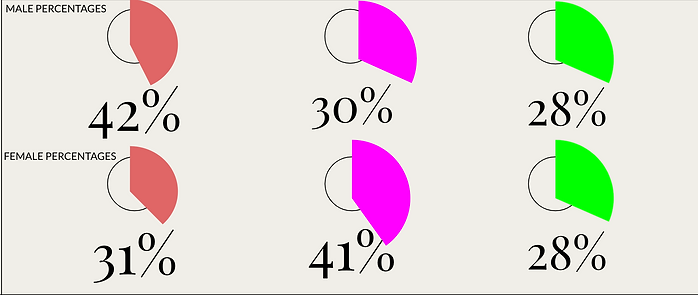Kendra Barr AP Research


Final Findings
Results
From the beginning of January to beginning of March my data collection took up a large portion of my time. Since all streaming platforms including, Disney +, Netflix, and Hulu were blocked by the district school Wifi, this process took a little longer than expected. Although all data was conducted through Google Sheets, including a color coded trait, along with at what time each trait occured. Once each show was coded and completed, all traits were counted up and divided by the total amount of traits seen over all ten episodes. Below are my final results for all shows.
Total Percentages

Fantasy

Educational
Action


Adventure

Musical

Discussion
These results show the clear personality traits that are portrayed in the children's TV shows targeting 5-8 year olds. As this age group is easily influenced as they are trying to establish their morals, values, and attitudes. The amount of negative traits that are portrayed are the same traits that are being taught to children as acceptable. As seen in the total percentages female dominated character shows have a larger percentage of negative traits portrayed than male dominated character shows. In each individual trait chart for each genre of cartoon, it is seen that female dominated shows carry a lot of weight with the negative traits. A large proportion of the total traits in each female dominated show were counted to be negative. This may be teaching children watching these shows that the large amount of negative traits portrayed are allowed. Traits such as greedy, picky, stubborn, and bossy were the four most seen traits in female dominated shows. As male dominated shows the most popular traits that were seen was clumsy, brave, rambunctious, and proud. The difference between the traits portrayed may be a prominent factor to a child's psychological development.
Conclusion
This research may just very well be the stepping stone to new and improved information on tv exposure and children. With a broader
knowledge basis this research could be done again but with high grade
equipment to produce larger findings, expanding individual knowledge
on the overall effect that media exposure has on children. Parents would be able to identify a child's tantrum, and whether or not it occured before or after tv exposure. The amount of time a television is on in one household could possibly be the answer to behavioral issues in children whether that be violence, cooperation, or basic etiquette. The results from this research simulation could allow parents and doctors to finally be able to get a hold of children's mannerisms, and possibly even control what they see off the media to manipulate what they believe to be "good" and "bad."
Children develop based off what they see around them, whether that be siblings, parents, teacher, or main characters on TV shows. Children are always watching to develop their own sense of values and beliefs, and this research may very well explain the reason an individual turns out the way they do.

Reflection
Below are the many questions that have yet to be answered about the inquiry process, and what it brought me personally as a researcher and growing individual.
How did you handle the uncertainty of the research process?
Throughout my research process, I had to deal with a variety of uncertainties that I was not anticipating. I encountered many uncertainties whether it was not being sure if the articles I found were going to be helpful to me to wondering if my data collection method was the best and most efficient option. One of the biggest uncertainties I found myself concerned with was wondering if I would be able to execute the coding process of my shows without pulling in personal bias, as it was never a process I had been through before. Using the abundance of resources that my instructor provided me and asking those with more knowledge on the coding and statistic test process, allowed me to confidently create a replicable model of data and push my uncertainty to the side.
If you could revisit your research process, what would you do differently and why?
If I could revisit my research process, I would have chosen a bigger variety of age groups to focus on to compare the different traits seen over a range of age groups. I would have done this because while my research is relevant to children developing morals and values, it is not exactly appealing to all age groups. While it was well fitting for my research question, to expand my age group would allow me to reach more individuals. This could contribute to a larger understanding of behavioral issues across all individuals, to whether or not teenagers are more likely to portray character traits seen rather than children.



